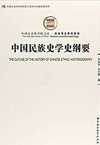Exploring history of Chinese ethnic historiography

The Outline of the History of Chinese Ethnic Historiography
For long, due to the dispersion, diversity and complexity of the research materials available on the history of Chinese ethnic historiography, the related research is mostly limited to a certain ethnic group, a certain stage or a certain topic, lacking a systematic and comprehensive work.
Co-authored by Shi Jinbo (a research fellow from the Institute of Ethnology and Anthropology at the Chinese Academy of Social Sciences, CASS) and Guan Zhiguo (a lecturer from Beijing College of Politics and Law), The Outline of the History of Chinese Ethnic Historiography attempts to fill this gap, arranging and analyzing the formation and development processes of the historiography of different ethnic groups since the pre-Qin era over two millennia ago, their major works and achievements, and stage characteristics.
Following the historical periods of ancient, modern and contemporary times, the authors systematically analyze the basic development processes of Chinese ethnic historiography. The authors point out that the concept of Huaxia (an ancient name for China) and ethnic minorities in Chinese history and its corresponding ethnic historiography research paradigm were mainly derived from the superior geographical conditions in the Central Plains and the relatively developed agricultural civilization that developed there. They were also influenced by ancient political concepts.
After the Opium War (1840–1842), the traditional concept of Huaxia and ethnic minorities gradually collapsed. The writing and research of ethnic historiography gradually got rid of the restriction of the traditional Han chauvinism, and began to focus on the pluralistic development process of the Chinese nation and the history of integrated development of the multi-ethnic country.
Since the founding of the People’s Republic of China in 1949, the study of Chinese ethnic historiography has been booming, and the understanding of the nature of ethnic historiography has continuously deepened. New theoretical models have emerged, such as the identity of a unified multi-ethnic country, the pattern of pluralistic integration of the Chinese nation, and the cohesiveness of the Chinese nation, which have guided the writing and research of Chinese ethnic historiography.
There are many ethnic historical documents written in languages of Chinese ethnic minorities over different periods in the country’s history. From the third chapter Ethnic Historiography of the Wei, Jin, Southern and Northern Dynasties (220–589), the book focuses on historical documents written in 17 languages of Chinese ethnic minorities, such as the Turkic script, the Tibetan script, the Khitan script, the Tangut script, and the Jurchen script, spanning from the 3rd century to the present.
Peng Fengwen is a research fellow from the Institute of Ethnology and Anthropology at CASS.
edited by YANG LANLAN
